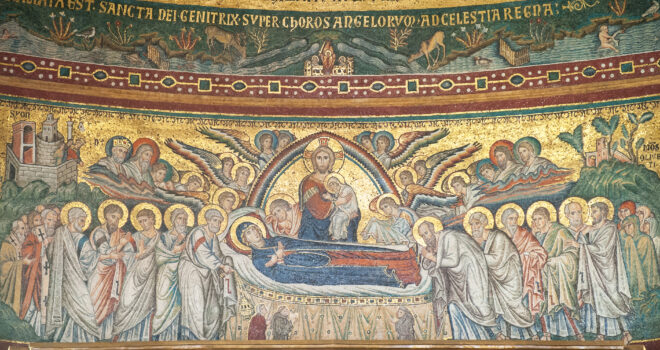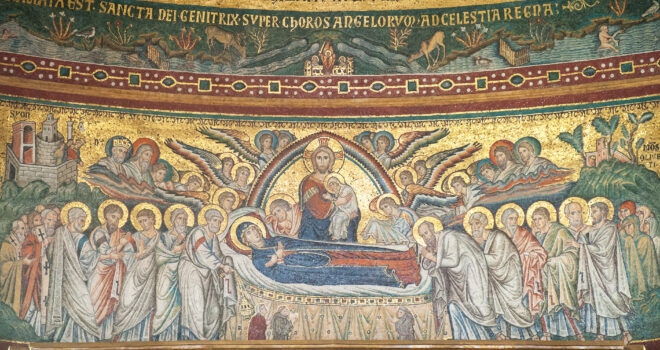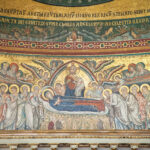August is crowned at its center point by the great solemnity of the Assumption of the Blessed Virgin Mary, the Church’s commemoration of Mary’s body being received into heavenly glory.
The details of Mary’s passing have been speculated upon by Christian thinkers for centuries, especially the question of whether Mary died or was assumed into heaven alive.
While the particulars of Mary’s passing have been lost in the fog of history, the patristic consensus seems to be that she died. This was not based on certain historical knowledge, however, so much as a general supposition that she went the way of all flesh, considering the unavailability of any other definite information about the end of her life.
References to Mary’s end are scarce in the first three centuries. Origen and Ephrem the Syrian mention her death in passing without commentary. The earliest substantial patristic commentary on Mary’s death comes from St. Ephiphanius of Salamis (c. 403), who addressed it twice in his work, Panarion. By the time of Epiphanius, veneration of the Blessed Virgin (both liturgical and popular) was on the rise, and many legends were springing up about Mary’s passing. Epiphanius eagerly reminded his readers that nothing definitive was known about the subject, although he offered various possibilities. The passages are worth citing in full:
But if some think us mistaken, let them search the Scriptures. They will not find whether she died or did not die; they will not find whether she was buried or was not buried. More than that: John journeyed to Asia, yet nowhere do we read that he took the Holy Virgin with him. Rather, Scripture is absolutely silent, because of the extraordinary nature of the prodigy, in order not to shock the minds of men. For my part, I do not dare to speak, but I keep my own thoughts and I practice silence. For it may be that somewhere we have found hints that it is impossible to discover the death of the holy, blessed one…I do not assert this absolutely, and I do not say that she remained immortal; but neither do I maintain stoutly that she died. The fact is, scripture had outstripped the human mind and left [this matter] uncertain, for the sake of that valued vessel without compare, to prevent anyone from harboring carnal thoughts in her regard. Did she die? We do not know. At all events, if she was buried, she had had no carnal intercourse.[1]
Elsewhere, in addressing the obscure sect of the Collyridians—who apparently offered sacrifices to the Blessed Virgin—St. Ephipanius says:
Either the holy Virgin died and was buried, then her falling asleep was with honor, her death chaste, her crown that of virginity. Or she was killed, as it is written: ‘and your own soul a sword shall pierce,’ then her glory is among the martyrs and her holy body amid blessings, she through whom light rose over the world. Or she remained alive, since nothing is impossible with God and He can do whatever He desires, for her end no one knows.[2]
St. Augustine, writing around the same time, also assumed that Mary experienced bodily death. He wrote that Jesus
…being born of a mother who, although she conceived without being touched by man and always remained thus untouched in virginity conceiving, in virginity bringing forth, in virginity dying, had nevertheless been espoused to a handicraftsman [St. Joseph], He extinguished all the inflated pride of carnal nobility.[3]
In the 5th century various legends called Transitus Mariae narratives began to circulate amongst Christians eager to fill in the details of how Mary’s end might have looked. The Transitus Mariae narratives are not historical; rather, they imaginatively reconstruct what Mary’s passing could have looked like. In that sense, they are a historical testimony to early Christian belief. St. John Henry Newman eloquently and imaginatively described how the Christians of this age may have developed the Transitus Mariae tales that became so popular in the Middle Ages:
Pilgrims went to and fro; they sought for her relics, but they found them not; did she die at Ephesus? Or did she die at Jerusalem? Reports varied; but her tomb could not be pointed out or, if it was found, it was open; and instead of her pure and fragrant body, there was a growth of lilies from the earth which she had touched. So inquirers went home marveling and waiting for further light. And then it was said, how that when her dissolution was at hand, and her soul was to pass in triumph before the judgment-seat of her Son, the Apostles were suddenly gathered together in the place, even in the Holy City, to bear part in the joyful ceremonial; how that they buried her with fitting rites; how that the third day, when they came to the tomb, they found it empty, and angelic choirs with their glad voices were heard singing day and night the glories of their risen Queen.[4]
During the mid-5th century, anxious to further enrich the imperial capital of Constantinople as the most glorious city in Christendom, the Emperor Marcian (r. 450-457) and his wife Pulcheria sought the body of the Blessed Virgin to bring her relics back to capital. They were informed by St. Juvenal, Bishop of Jerusalem, that though Mary had indeed died in Jerusalem, her tomb had been opened by the Apostles and found empty. From this the Apostles concluded that the body had been taken up into heaven.
Moving to the Middle Ages, there is an interesting reference to Mary’s death that comes to us through the Veneranda prayer. The Veneranda is a collect from the 10th century Gregorian Sacramentary, which subsequently made its way into the Sarum, Dominican, and other non-Roman Latin rite missals. Here is the collect as it appears in the Sarum rite:
Let the honoured festival of today, O Lord, bring us continued aid; on which the Holy Mother of God underwent temporal death, yet could not be holden by the bonds of death because she bore incarnate of herself Thy Son our Lord. Who liveth etc. [5]
We should also mention one other work, known as the Liber de Assumptione, an early 12th century tract that was probably written by a disciple of St. Anselm of Canterbury. The anonymous author of the tract states:
Mindful of the fact that Mary was human, we are not afraid to say that she underwent temporal death, which death also her Son, who is both God and man, sustained because of the law imposed on the human race: and this because as man He was conceived in and brought forth from her womb…Would it therefore, be wrong…[that]…we say that she, through whom God wished to be born and to share in the substance of the flesh, indeed underwent the death of the human race but was not restrained by the bonds of death?[6]
Two things are noteworthy about this text: first, author argues the fittingness of her Assumption on the grounds of her perpetual virginity and divine motherhood; second, the tone of the tract seems to be apologetical—by the early 12th century, the alternate view (that Mary never died but was assumed alive into heaven) was gaining momentum, such that the author of the Liber de Assumptione felt the need to refute it.[7]
Indeed, the contrary opinion—that Mary was exempt from the sting of death and taken into heaven alive—seems to have its origin in Marian legends of the Middle Ages. It did not begin to gain substantial following until the Baroque era, due to the influence of a few theological works of the 17th and 18th centuries. Arguments in favor of her immortality were strengthened after the proclamation of the dogma of the Immaculate Conception in 1854. The matter became the subject of intense controversy during the 20th century, such that a petition was made to the Holy See in 1949 to clarify the matter. No declaration was made by the Holy Office, but the controversy was sufficient to deter Pope Pius XII from making any statement on the question when he promulgated the encyclical Munificentissimus Deus in 1950. [8] The pope chose instead the more diplomatic phrase “having completed the course of her earthly life.”[9]
Today one will find both opinions among Catholics. While neither opinion is “right,” it seems that Mary’s death was the majority opinion throughout most of Church history, being challenged only in more modern times. Whatever we believe about the circumstances of her passing, however, we can be assured that she reigns in splendor with her son in a state of bodily glorification, which we commemorate every August 15.
Those interested in learning more about this topic should consult The Testimony of the Patristic Age Concerning Mary’s Death by Fr. Walter J, Burghardt, S.J.[10] Also, my own work The Feasts of Christendom contains many interesting facts on the Assumption and other major feasts.
[1] St. Epiphanius, Panarion, Haer. 78, 23
[2] Ibid., 79
[3] St. Augustine, On Catechizing the Uninstructed, 22. He also references Mary’s his Exposition of the Psalms XXXV:14, as well as Tractates on the Gospel of John VIII:9.
[4]John Henry Cardinal Newman, Discourses to Mixed Congregations (Longman and Green, London, 1906), 373
[5] F.E. Warren, The Sarum Missal in English (London, A. Moring, 1911), “Collect for the Assumption.”
[6] The anonymous author of the Liber de Assumptione is known as “Pseudo-Augustine.” Liber de Assumptione, quoted by A. Janssens, in The Assumption of Our Lady (Fresno, California: Academy Library Guild, 1954), 6; PL XL, 1143 and 7; PL XL 1145
[7] St. Thomas Aquinas references the Liber de Assumptione of Pseudo-Augustine in Summa Theologiae, III, 27, 1, which he erroneously attributes to St. Augustine of Hippo.
[8] Votum SS. Dno. Pio XII prolatum de corporea Asumptione B. M. Virginis in coelum, post mortem, definienda, in Estudios Marianos, Vol. 9, 1950, p. II ff andAlma Socia Christi. Acta Congressus Mariologici-Mariani Romae anno sancto 1950 celebrati. Vol. I: Congressus ordo et summarium (Romae, 1951), p. 104.
[9] Pius XII, Munificentissimus Deus, 44
[10] Walter J. Burghardt, S.J. The Testimony of the Early Church Concerning Mary’s Death (Westminster, MD: Newman Press, 1957).
Photo via Shutterstock












